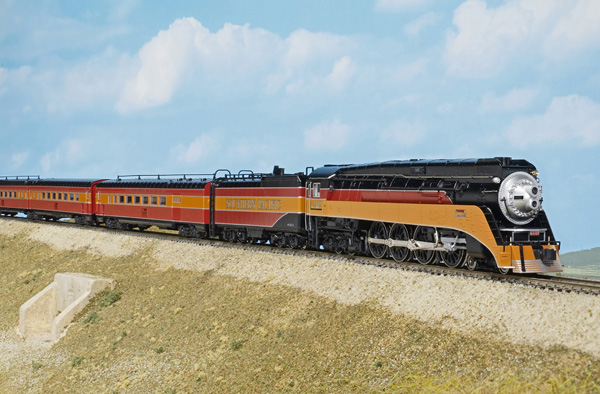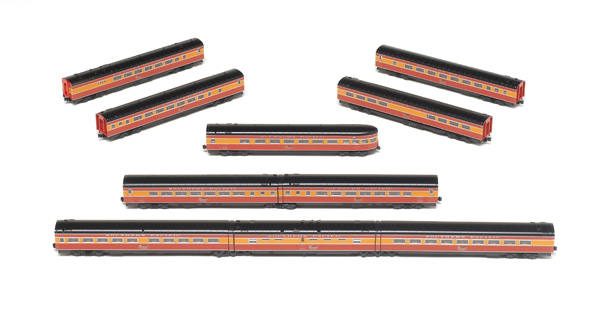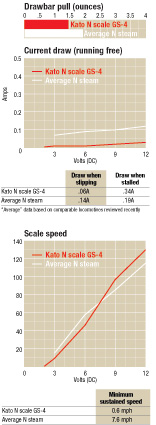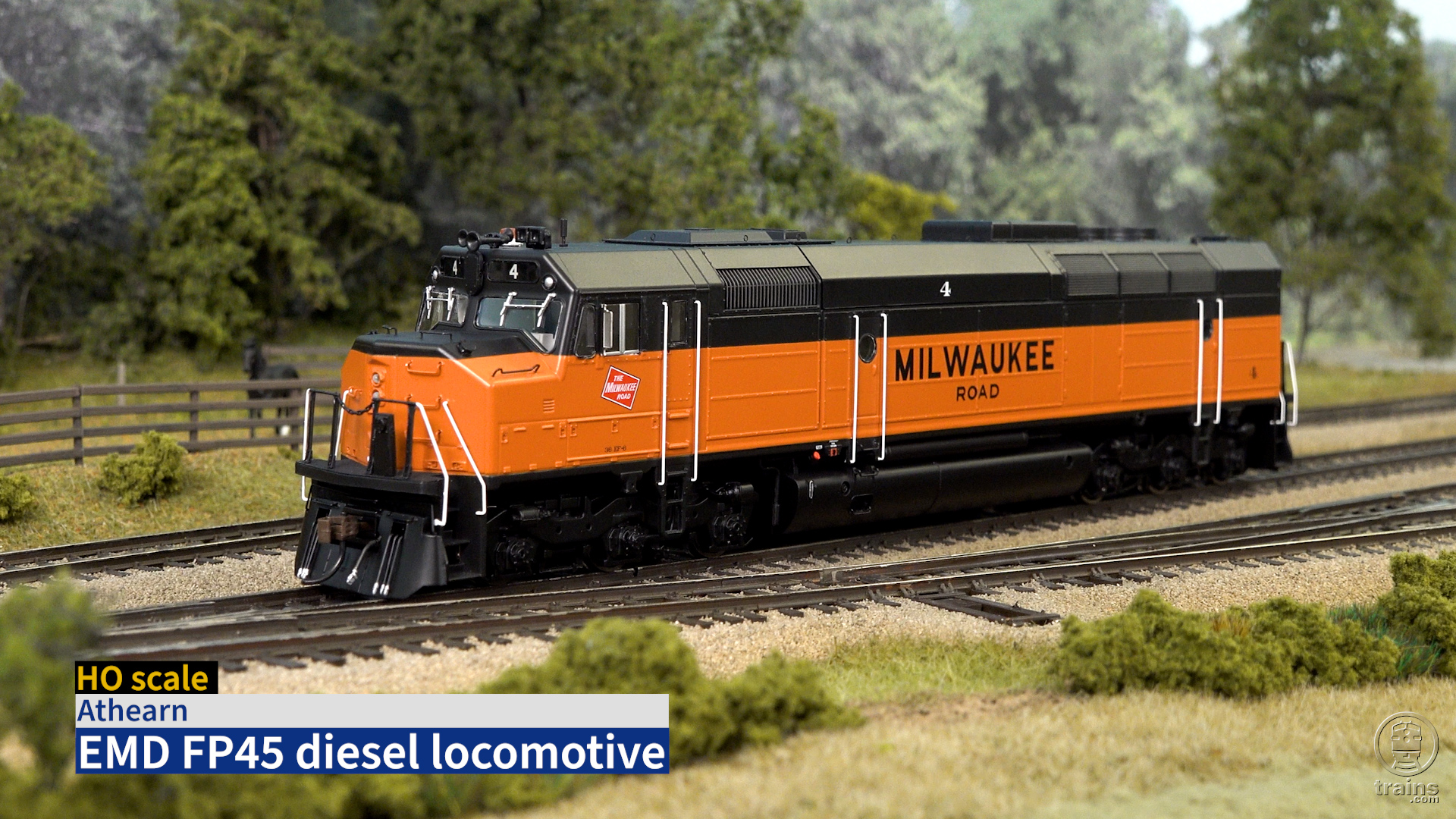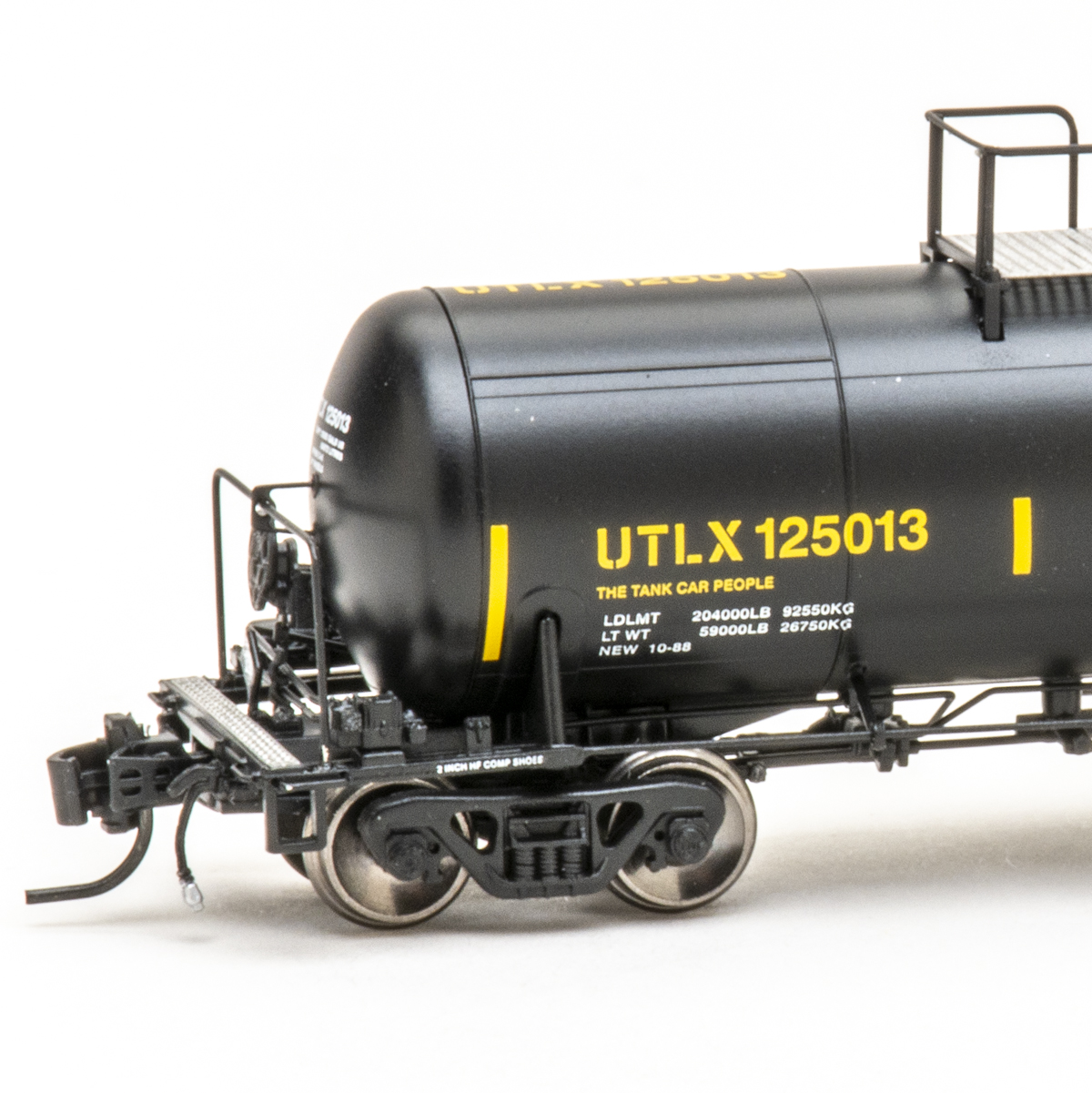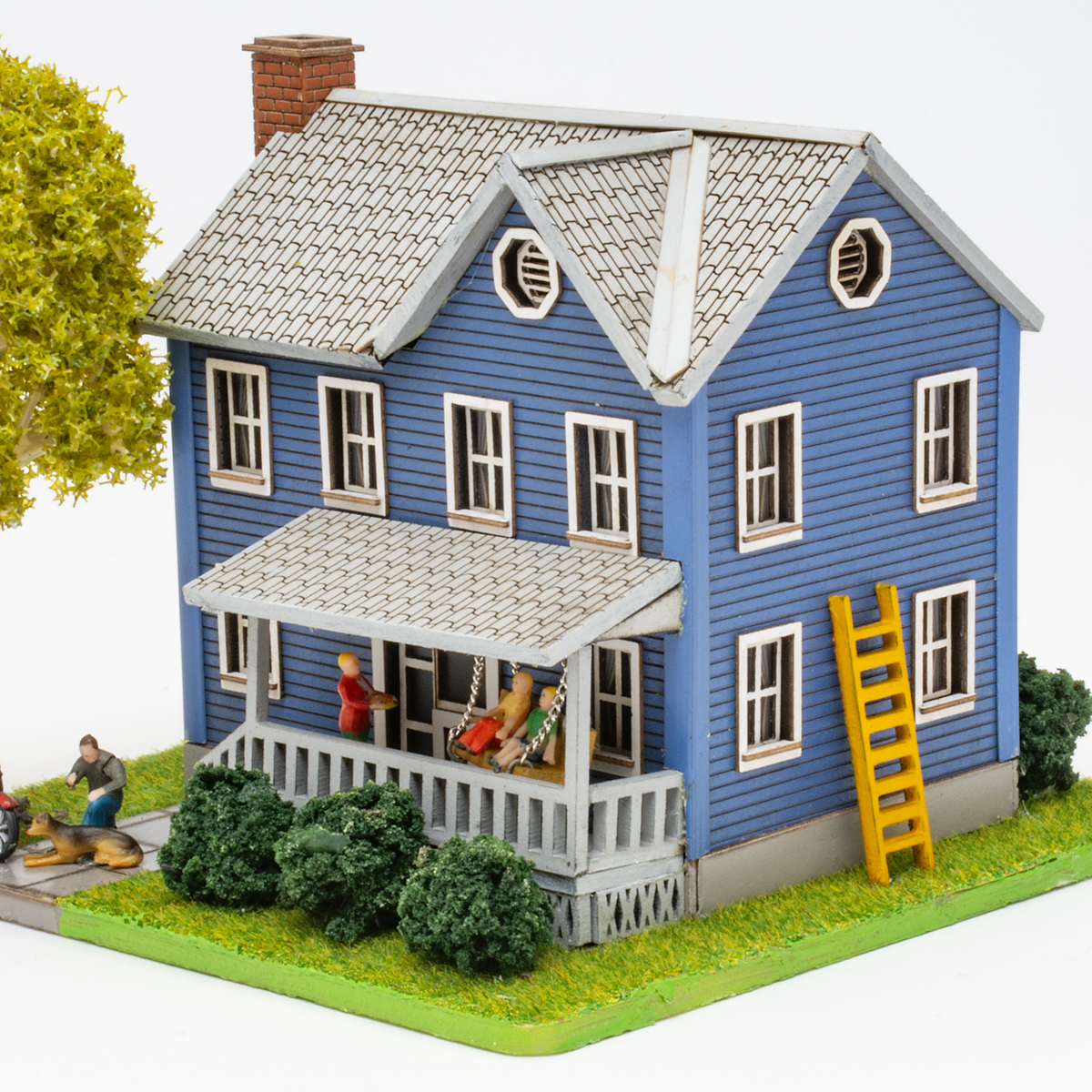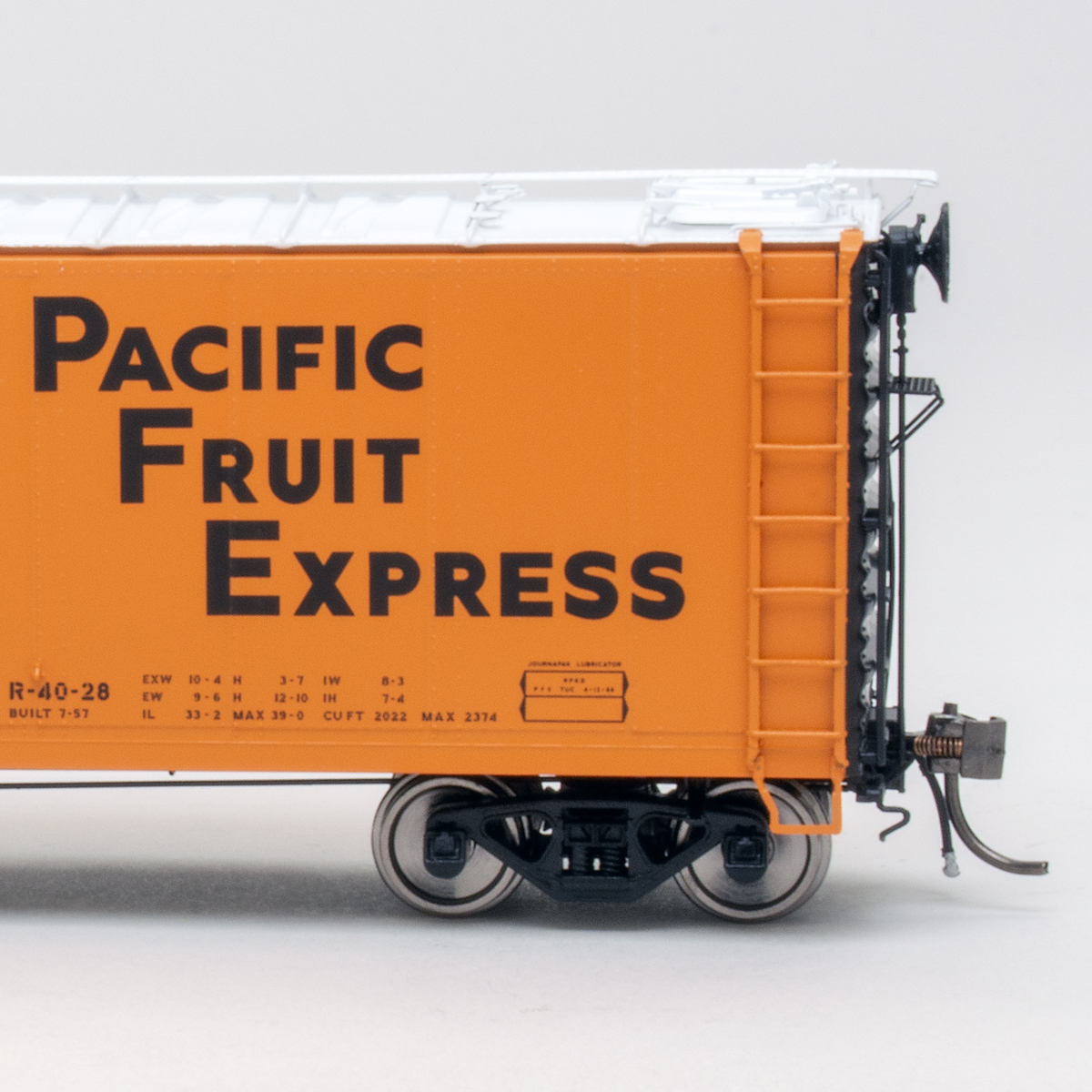We reviewed both the N scale GS-4 and the 10-car Morning Daylight set. The GS-4 performed well on DC and looked great pulling the matching passenger cars around a scenicked N scale layout.
Pullman-Standard built all the streamlined cars for the 1937 Daylight. The company delivered new equipment for trains 98 and 99 at the end of 1939, including a three-unit articulated coffee shop/kitchen/diner. By 1946 the Daylight had grown from a 12-car to an 18-car consist. (To handle troop movements, the trains ran in 20-car consists during World War II.)
New motive power arrived for the Daylight in 1941 when Lima Locomotive Works delivered 30 class GS-4 4-8-4 locomotives, and two roller-bearing equipped duplicates classed GS-5. Like the previous GS-3 and GS-2 classes, the GS-4 and GS-5 engines had skyline casings and side skirts and were painted in a red and orange livery to match the cars. These locomotives led Nos. 98 and 99 until diesels took over the route in 1957. Southern Pacific no. 4449 is the only surviving GS-4, and it still runs in excursion service.
The N scale GS-4. The Kato model came decorated as no. 4449 in post-June 22, 1946 livery. At that time the SP stopped using the word “Lines” on its equipment and used 15″ lettering across the sides of locomotive tenders.
The lettering and pinstripes on the model are in SP lettering gray. The road name, cab number, and Daylight herald are all edged in black like the prototype. The pinstripes aren’t edged in black.
All lettering and heralds are crisp, straight, and match prototype photos. The orange and red stripes on the locomotive and tender are in alignment.
The Kato N scale GS-4 matches drawings in the April 1972 issue of Model Railroader.
Both the locomotive and tender have plastic body shells with sharply engraved detail. The tender deck has planking with simulated wood grain and molded hatches.
The GS-4 also has many separately applied parts, such as handrails, pilot air hoses, and non-functioning classification lamps. A plated airhorn is correctly placed in the skyline casing above the front of the boiler.
The windows on the vestibule cab have glazing. Although it’s difficult to see without removing the roof, the cab interior features an engraved backhead as well as seats for an engineer and fireman. Figures are not included.
The model comes with factory-installed train indicator boards for No. 98. User-installed boards are included for No. 99 and X4449. The “X” with an engine number indicates an extra train with no timetable schedule.
Drivetrain and electronics. The locomotive’s plastic cab and boiler are press-fit and easy to remove. Inside the boiler, a three-pole skew-would motor with a brass flywheel is connected to a gearbox that drives the third axle. The model’s siderods transfer power to the rest of the drivers.
The motor is housed inside a split cast-metal frame. This weight along with traction tires on the third drivers give the locomotive enough drawbar pull to haul the equivalent of the full Daylight consist of 18 N scale passenger cars on straight and level track.
A printed-circuit (PC) board on top of the frame controls lighting functions. A separate PC board in the tender controls the motor.
I carefully removed the press-fit tender shell and metal weight, revealing the PC board. The GS-4 is designed for conversion to Digital Command Control (DCC), and Kato makes a drop-in motor decoder (part no. EM-13) that replaces the PC board in the tender.
As of this writing there is a factory defect with the GS-4 that causes it to short out on DCC. Kato is aware of the problem and provides a DCC retrofit tender insert kit for the locomotive. You can contact your nearest Kato dealer to have this kit and the decoder installed in your GS-4. If that’s not possible, you can contact Kato directly at www.katousa.com. To avoid damaging the decoder or the locomotive, you should not operate the model using DCC until the tender insert kit is installed.
At 2 volts, the locomotive rolled steadily at only .6 scale mph. Throughout its speed range, the locomotive’s mechanism is very smooth and quiet. At 12 volts, the model reached 130 scale mph, which is higher than the prototype’s 110 mph top speed.
I ran the locomotive and cars through an 11″-radius curve of Kato Unitrack without any derailments. The train looks a lot better on 18″-radius or wider curves.
A full consist. The Kato Morning Daylight 10-car set matches car types and car numbers found in a March 30, 1946 consist list for No. 98 reproduced in the book Southern Pacific Daylight Vol. 1 by Richard K. Wright. The car numbers of the articulated chair car add-on sets also match this list. The models have newly tooled body shells. Kato based the models on the cars built in 1939 and 1941 to replace original Daylight equipment.
The cars’ window arrangements and fluting match prototype photos. All the cars match prototype drawings in The Official Pullman Standard Library Vol. 5 Southern Pacific Prewar Cars.
The most interesting cars in the Kato set are the three-unit articulated coffee shop/kitchen/diner and the two-unit articulated chair cars. These cars share trucks between units and have full-width diaphragms just like their prototypes.
Car construction. The cars have press-fit plastic body shells. The interior floors feature molded walls, seats, and other details. A metal weight is sandwiched between the interior floor and the chassis.
Like the GS-4, the cars are painted in post-1946 livery. All striping and lettering is straight. The orange and red bands along the carbodies line up between the cars and the locomotive.
The trucks all have metal contacts installed, so all the metal wheels pick up track power. Kato offers separate interior lighting kits for these cars.
The parlor-observation car features factory-installed external lighting. My favorite features of the N scale Daylight are the lighted marker lights, taillight, and tail sign. The tail sign has the correct herald for the 1946 train.
The non-articulated cars don’t have diaphragms, unlike their prototypes. The cars also have a 3/16″ gap between them when coupled. For more prototypically close coupling, Kato also sells a set of its Kinematic knuckle couplers that fit these cars. These couplers have movable shanks that hold cars close together on straight track and extend on curves.
A well-matched set. I ran our review sample 10-car set behind the Kato GS-4 on Jim Kelly’s N scale Tehachapi Loop layout. (Jim is a retired Model Railroader managing editor.) The Morning Daylight looked great rounding 18″ curves, and the GS-4 pulled the 10 cars up a 2.75 percent grade.
The Kato Morning Daylight passenger cars and GS-4 accurately depict their famous prototypes. Unfortunately the Kato GS-4 wasn’t DCC-ready right out of the box, but we hope that issue will be resolved for future runs of the locomotive. Now that Kato provides a fix for the GS-4, DCC operators can also enjoy an accurate model of what many railfans consider the most beautiful train in the world
Price: $198 (GS-4), $250 (10-car set), $50 (articulated chair car set)
Manufacturer
Kato U.S.A. Inc.
100 Remington Rd.
Schaumburg, IL 60173
www.katousa.com
Description: ready-to-run locomotive and passenger cars
Locomotives: no. 4453, no. 4449
10-car set: baggage-chair 3302; three-unit articulated coffee shop 10258, kitchen 10257, dining car 10256; chair car 2492; articulated chair cars 2473 and 2474; tavern car 10315; parlor car 3002; parlor-observation car 2955
Articulated chair cars: nos. 2457 and 2458; 2477 and 2478; 2479 and 2480; 2467 and 2468
Drawbar pull: 1.5 ounces
Electrical pickup on six drivers and 12 tender wheels
Illuminated train indicator boards
Kato knuckle coupler on rear of tender and front of pilot at correct height
Minimum radius: 11″
Operating signal light
Optional user-installed long-shank coupler on pilot
Metal RP-25 contour wheels in gauge
Three-pole skew-wound motor with metal flywheel
Weight: 5.5 ounces (engine and tender)
Detailed interior
Illuminated tail sign, taillight, and marker lights
Kato knuckle couplers at correct height
Low-profile metal wheels in gauge
Minimum radius: 11″
Weight: 1 ounce per car





